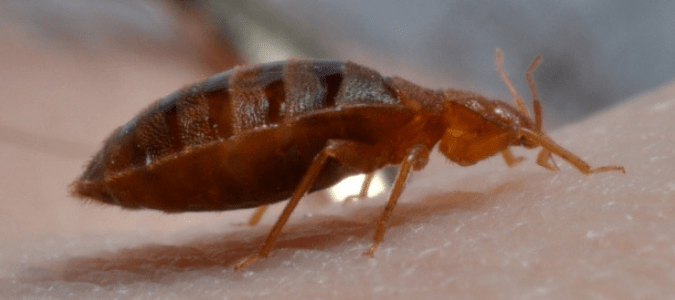
If you’ve had an experience that led you to suspect the presence of bed bugs in your couch, you might wonder if that’s even possible. The name “bed bugs,” after all, suggests these pests are found in people’s sleeping areas, not their living room furniture. But anyone who’s ever dozed off on the couch while watching their favorite TV show and then later found lines of itchy red bumps on their skin knows that isn’t true.
Bed bugs definitely don’t restrict themselves to beds, although they are most often found in places where people sleep. That’s because they are safest when they feed on the blood of their victims while they are still, often when a person is fast asleep. Bed bugs have been known to infest many types of furniture and spaces where people spend lots of time, including couches, sectionals and easy chairs. So, if you suspect there are bed bugs in your couch, what should you do?
First and foremost, stay calm and don’t panic—as tough as that may be to do. While you could have bed bugs in your couch, it’s also possible that you’ve been bitten by a bug that looks like a bed bug, such as a flea. If you’ve spotted other signs that your couch may be infested with bed bugs, such as tiny black spots or streaks on the upholstery, it still isn’t necessarily a definitive sign pointing to a bed bug infestation. In fact, the National Pest Management Association’s Bed Bugs Without Borders Survey found that 84% of calls from homeowners about other types of pests actually resulted in the positive identification of bed bugs. The best way to be absolutely sure is to have a licensed pest management technician come to your home to provide you with a professional inspection.
Before reaching out to a professional, many people want to make an initial search for telltale signs of bed bug activity. To do this, grab a flashlight, a magnifying glass and a pair of protective rubber or latex gloves to assist you in your search. Bed bugs tend to hide along the edges and seams of cushions and mattresses, tucking themselves into tiny spaces, which is why the flashlight and gloves may come in handy. Some people also use a credit card wrapped with double-sided tape to stick into these small spaces and withdraw any evidence of bed bugs that might stick to the tape. You might also want to have a sealable plastic bag on hand to hold any insect bodies, exoskeletons or eggs that you may find, so you can later show them to a pest control specialist for identification.
Once you’re ready to begin your search, here’s what to look for:
- Actual bed bugs, whether alive or dead, or their nymphs or eggs. Adult bed bugs are small, brown insects with flat, oval-shaped bodies that are about the size, shape and color of apple seeds. Baby bed bugs look like smaller and paler versions of their adult counterparts, while bed bug eggs are tiny, white and translucent, and difficult to see with the naked eye.
- Shed bed bug exoskeletons. Bed bugs shed their skins at several points throughout their life cycle, so if you have a bed bug infestation in your couch, bed or some other area of your home, you might find shed skins that indicate that live, growing bed bugs are nearby.
- Tiny black spots or streaks on the upholstery or inner cushions. These little black spots might bleed on the fabric like pen ink, and could be bed bug feces.
- Brown or rust-colored blood stains on the upholstery or inner cushions. These may result from bed bugs feeding on their human hosts.
One of the most common telltale signs of a bed bug infestation is itchy red bumps or welts on your skin, especially those that show up in a line pattern. It’s important to note that not everyone reacts to bed bug bites in the same way. Some people don’t react to them at all, while others find them intensely itchy. Bed bug bites can also sometimes turn into blisters before they go away.
If the very idea of bed bugs makes your skin crawl, it’s understandable. While bed bugs don’t carry diseases, their itchy bites have been known to lead to serious secondary infections like staph or MRSA. Beyond that risk, these pests have a bad reputation for plenty of other good reasons. They are masters at hitchhiking to new places in people’s luggage or on secondhand furniture, which is how they infest new homes and regions. They’re also experts at staying hidden during daylight hours, which is why most people don’t realize they have a bed bug infestation until it’s too late. Worse still, they can hide away for months between feedings. That means that they often re-emerge after you assume your infestation is over.
Bed bugs are notoriously difficult to get rid of on your own, and they’re very tough to kill. Unfortunately, many insecticide products don’t have the desired effect on bed bugs, since these pests have developed a growing resistance to chemicals that used to be effective in eradicating them. This is why many pest control specialists agree that insecticides can play only a partial role in controlling bed bug infestations. Other treatments and strategies must also be used for a comprehensive, multi-faceted approach that succeeds in killing off bed bugs at all stages of their life cycle.
If you do find evidence of bed bugs in your couch or any other area of your home, the next step is to call in a pest control specialist to assess the situation. In the meantime, don’t take blankets, sheets or other items away from the potentially infested area, since doing so could introduce live insects to new areas of the home. It’s best either to leave everything as is until a pest management specialist can advise you on next steps, or to wash and dry any items on the highest heat setting possible, since heat can kill off bed bugs and their eggs.
Couch cushions that have been infested can also be sealed in black plastic bags and left outside on a hot, sunny day, since the heat that builds up inside the bag can kill off the bed bugs. Since these creatures can survive in a wide range of temperatures, keep in mind that temperatures will need to get quite high to kill bed bugs and their eggs. Bed bugs and their nymphs and eggs can also be vacuumed away. If you choose to vacuum them up, you’ll have to be extremely thorough, and be sure to dispose of all bed bug residue in a tightly sealed bag that you throw away in an outside garbage bin.
Because heat kills bed bugs, you may be curious if using a steamer in bed bug-infested areas could be another home remedy to your pest problem.

Will A Steamer Kill Bed Bugs?
While hot steam can be a highly effective method of killing off bed bugs in all stages of their life cycle, it has to be applied correctly to work. Hand-held steamers intended for taking the wrinkles out of clothing won’t be effective on bed bugs, nor will the carpet cleaning machines that you can rent from your home improvement store. Neither of these types of machines can reach a high enough temperature to kill off bed bugs.
Higher-capacity commercial steamers can effectively kill off bed bugs and their eggs if the steam reaches a temperature that is lethal to the insect pests—namely, at least 160 degrees Fahrenheit on the surface being treated. Hot steam can kill bed bugs living on the surface and up to three-quarters of an inch into the fabric or stuffing, and can even kill bed bugs that are hiding up to a couple of inches into a crack or crevice.
Of course, using hot steam to kill bed bugs comes with some risk. It can be very easy to burn yourself accidentally or damage your household items when applying steam. Also, hot steam kills only the bed bugs and eggs that it can reach; any insects that are untouched will be unaffected by the steam treatment. Steam treatments often have to be reapplied several times to take full effect. For all of these reasons, it can be faster and easier to hire a professional rather than trying to do it yourself.
In the midst of dealing with a bed bug infestation, it’s only natural to wonder how you got bed bugs as well as what you can do to prevent another infestation from happening.

How Do Bed Bugs Spread From House To House?
Bed bugs are natural hitchhikers—meaning, they travel from one place to the next by clinging onto clothing, furniture or other items, and hitching a ride. This is why travelers should be cautious, no matter where they go. Bed bug infestations can happen anywhere, including the cleanest and most expensive accommodations. If you travel, always be sure to place your suitcases on a luggage rack rather than on the floor, inspect the bed carefully for any signs of bed bug activity and bring a sealable plastic bag that you can use to bag up your items before you return. Upon returning home, you can leave the bag out in the sun to kill off any potential bed bugs, or transfer your clothes directly from the bag into your washing machine. It’s also smart to bag up your suitcase itself and leave it out in the sun, since bed bugs can easily hide inside luggage.
Travelers aren’t the only people vulnerable to bed bugs. These insects can also get into people’s homes by way of secondhand furniture and clothing, which is why it’s so important to check thoroughly for bed bugs if you’re considering bringing used goods into your home. As we have already mentioned, bed bugs can actually live for months at a time without consuming a blood meal. That means that a variety of items, including garage sale clothing or a thrift store sofa, might be providing hidden shelter to live bed bugs, even if it hasn’t been used in months. It’s smart to inspect secondhand items very carefully before bringing them home, or avoid them altogether if you want to take every step to avoid getting bed bugs or having to deal with a re-infestation.
No matter how bed bugs got into your home, the best way to get them out is by contacting a pest control professional who can implement reliable pest control solutions.
ABC Can Handle Your Bed Bug Problem
Between the mental toll these pests can have on a homeowner and the lack of sleep that is associated with a bed bug infestation, dealing with this type of problem can be exhausting. Instead of trying to handle bed bugs on your own, contact the reliable pest control experts at ABC Home & Commercial Services. We will create a custom treatment plan to target the bed bugs in your home, so your life can go back to normal.